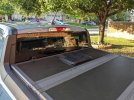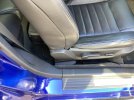As an update for my setup with the NECESPOW 322Wh and a solar panel. I mounted the solar panel like I described a previous post (
here). I currently have the solar output going directly into the power station DC input, and a fuse tap charging via USB-C when the truck is running. The USB-C seems to generally be charging at ~50W (the adaptor should be able to do 65W, but I don't seem to see that with my setup). I have my dashcam to do parking recording based on events and motion, and its probably over-sensitive. My drive to work is usually about 1hr15min total (out+back). Using only the USB-C charging while driving, the power station would run down after 1-1.5 weeks, then need to be taken inside to recharge. Since hooking up the solar, it seems to stay pretty much fully charged, but the display on the NECESPOW doesn't give you much reliable info on the actual charge state. I can only really tell that it is fully charged when it exits charging mode with power connected (battery indicator not blinking). I purchased a digital meter to monitor the amount of solar power I am getting (
this one, but there are lots identical on Amazon). I have it wired with
these barrel connectors, and have any easy point under my bed cover to plug in the meter. While parked at work on a sunny day, from 8am until 4pm, I get around 85-90Wh. That works out to a little over 10W on average over that 8 hours. The sun is pretty low on the horizon at 8am though, so some of the time the output is probably pretty low. Full noon sun seems to get about 15-17W (the panel is sold as 20W). Overall, it is working out pretty well. Here is what the setup looks like:

I mounted it using some aluminum angle, and used a just the gland nut off of
one of these from Amazon. The panel has a little air space below it, and I can still fold the cover back without anything touching the panel.
Here are a few of my thoughts:
- The power gauge on the NECESPOW power station is very unreliable. It very difficult to know exactly what level of charge it is at (unless it out or completely full).
- The solar panel does poorly on cloudy days, but has enough to keep the power station in "charging" mode (battery status flashing). I am wondering if it burns more battery staying in "charging" mode when the solar input is very low, but I can't tell for sure (see statement above).
- I like having the
power meter, but I can currently connect it in the bed of the truck, but I don't want to leave it there while driving. I may adjust the wiring so that I can keep the meter inside the truck. I also may get another to measure how much the dashcam is actually using (to play with parking recording settings).
- The NECESPOW has a 12 hour timer, so it sometimes shuts off parking if I haven't driven in more than 12 hours. I was hoping that the solar panel would keep it on (the solar charging keeping the 12 hour shutdown reset). I still have it stop parking recording overnight some times, so either we have 12 hours without enough sun to put the power station in charging mode, or something else it going on.
Overall, its all working very well. The dashcam works flawlessly (back and forth between driving mode and parking mode). Except for extended cloudy days, it keeps the power station pretty close to full I think.





